Home Safety Checklist For Baltimore
Being safe in your home should be your topmost concern. But are you overlooking some key safety components? Look over this home safety checklist for Baltimore and find out where your home needs an update.
This guide begins with some whole-home safety techniques, and then we whittle it down room-by-room. Then, call (410) 934-3289 or fill out the form below for more information.

Essential Home Safety Checklist for Baltimore
While you should use a room-to-room process for home safety in Baltimore, there are a few things that are good for your entire home. These components can talk together through a wireless hub, and oftentimes respond to other components. You can also manage every one of your home safety equipment through a mobile security app, such as ADT Control:
-
Monitored Security System: All your doors and windows should use a sensor that alerts you and your family to a break-in. When an alarm triggers, your monitoring center picks up the alert and quickly contacts emergency personnel.
-
Smart Lights For Most Rooms: Of course, you can program your smart lights to make your house more efficient. But smart lights can also allow you to stay safe throughout an emergency. Make your downstairs lights come on when an alarm goes off to frighten off burglars or light a path to a safe location.
-
Smart Thermostat: Likewise, a smart thermostat in Baltimore should save you up to 15% in utility costs. Also, it can turn on your exhaust fan if you have a fire.
-
Monitored Fire Detectors: It’s code that you have a fire alarm on each level of your house. You can increase your fire readiness by hanging a monitored fire alarm that senses both smoke and heat, and notifies your round-the-clock monitoring agents when it detects a fire.
-
Smart Door Locks: Every door that needs a keyed lock can use a smart door lock. Now you may set numbered codes to family and friends and receive notifications to your phone when the locks are unlocked. Your locks can even automatically unlock, allowing you to quickly get out during a fire or dangerous situation.
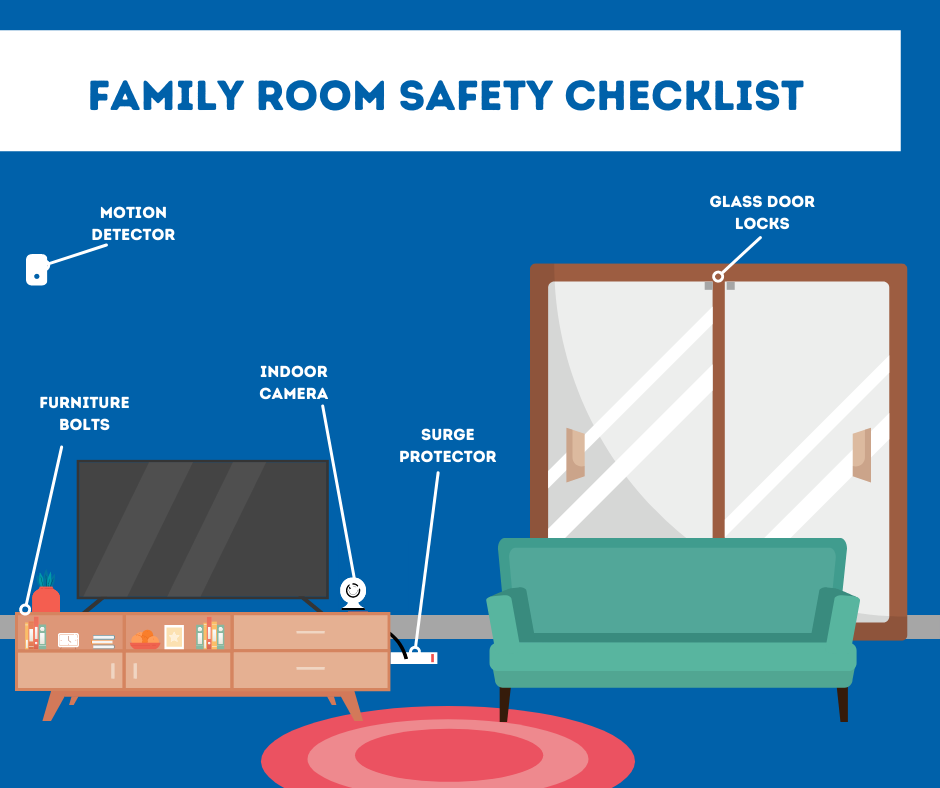
Living Room/Family Room Safety Checklist For Baltimore
You’ll hang out most in the living room, so it may be the best room to improve your home safety. Highly sought after items, like your TV or stereo system, typically reside in your living room, making it a tempting room for thieves. Begin with installing a motion sensor or indoor camera in your room, then take a look at the following suggestions:
-
Motion Sensors: By putting in motion sensors, you’ll get a loud siren anytime they sense unexpected motion in your family room. Look for motion detectors that filter out pets or you’ll get an alert each time your pet comes in for a drink of water.
-
Indoor Security Camera: An indoor security camera puts an eye on your family room. View constant streams of the area so you can see what’s downstairs through the mobile app. Or talk with family members when they arrive back from school using the two-way talk feature.
-
Surge Protector/Cord Maintenance: Protect those electronics and quit overtaxing your circuits with a surge protector. For added convenience, install a smart plug with a surge protector in the unit.
-
Entertainment Center Secured To The Wall: If you have curious kids, you’ll want to attach your heavy furniture and entertainment center to your wall. This is extra important if your family room uses carpeting that could make heavy objects extra wobbly.
-
Special Locks For Sliding Doors: If your living room uses a sliding glass door that leads to a deck, patio, or outside porch, you already can see that the door lock is usually flimsy. Put in a custom lock, like a metal bar or small locks that bolt to the top and bottom of the frame.
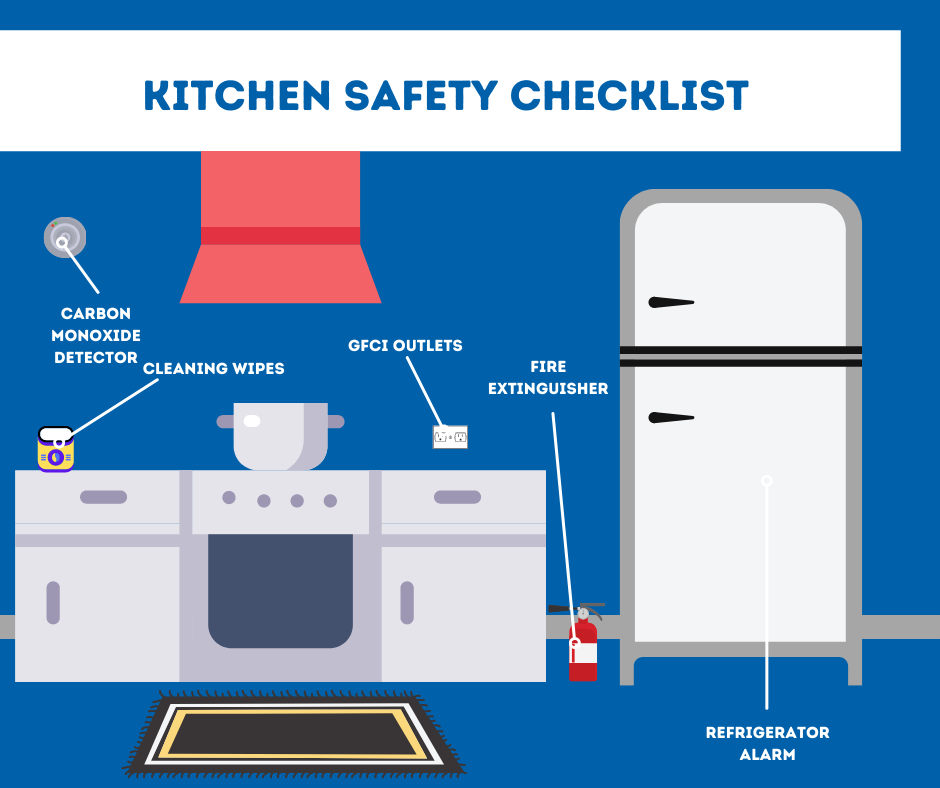
Kitchen Safety Checklist For Baltimore
Your kitchen has room for items that can bring comfort and safety to your home. Many of these objects are also a snap to add and should be purchased from the Target or Walmart:
-
Fire Extinguisher: A fire can happen from a neglected pot or an errant grease splatter. Always have a fire extinguisher in close reach for any cooking emergencies.
-
Circuit Interrupter Box On Each Outlet: A circuit interrupter outlet should be standard everywhere there’s nearby water to prevent electrocution. That includes the outlets around your sink and kitchen counter. Since the late ‘80s, it’s been required to have one circuit interrupter outlet per dedicated circuit. But all your outlets will go if one outlet senses a surge, so you’re going to want to use a single GFCI for every outlet.
-
Monitored CO Detector: A carbon monoxide detector is recommended for the kitchen if you use gas for the stove and oven. If your gas burners leak, the carbon monoxide detector will emit a loud siren and call your monitoring agent.
-
Disinfectant Wipes Or Spray: The largest safety hazard in the kitchen is the invisible bacteria and cross-contamination that comes with raw meat and vegetables. Always keep antiviral wipes or spray to sanitize your surfaces before and after cooking.
-
Freezer and Refrigerator Alarm: The food items in your fridge need to remain at a chilly temperature to stay ready to eat. If you accidently leave the fridge or freezer door open too long, then a small beep will remind you to close the door. Some refrigerators already have this installed, some won’t, and you’ll have to pick up an external alarm from the store.
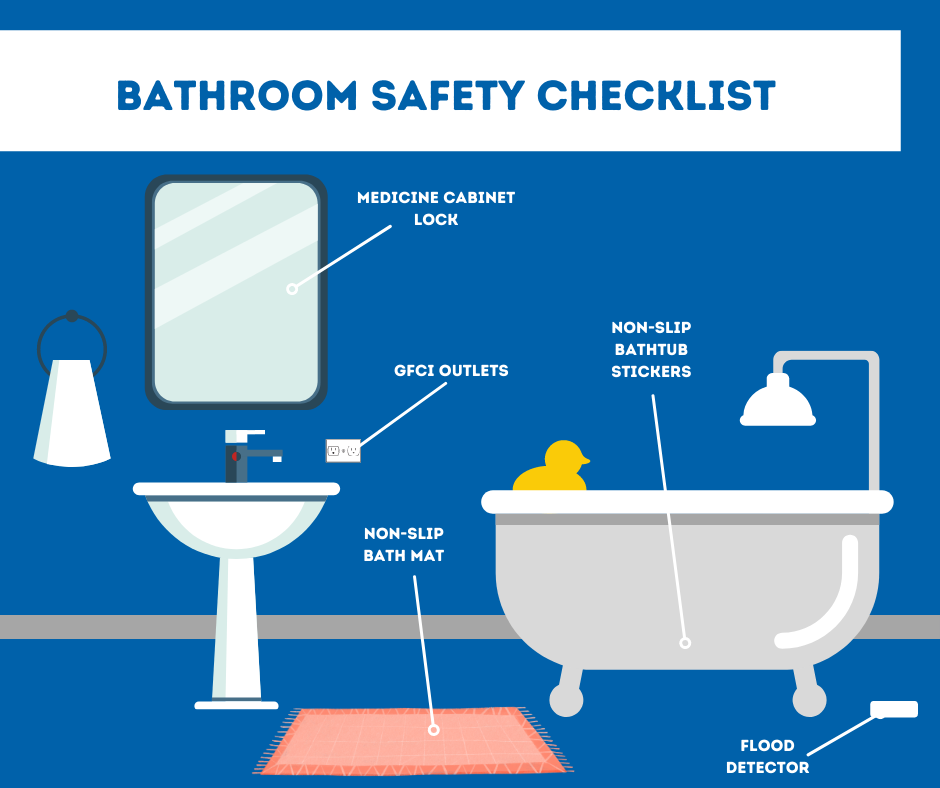
Bathroom Safety Checklist For Baltimore
Just because there’s not a lot of space in your bathroom doesn’t mean that there aren’t safety issues. From flood prevention to anti-surge outlets, here are five safety ideas for your bathroom:
-
Flood Detectors: A leaking sink or shower can create a whole lot of water damage. Get alerted early about pooling water with a flood detector before they bring about hundreds of dollars in ruined floors, walls, and fixtures.
-
No-slip Bath Mats: A fall in the bathroom can be painful, causing bumps, gashed heads, or broken bones. You can steer clear from these hazards with a textured bathroom mat for your wet feet.
-
Textured Bathtub Strips: Like a tiled floor, a tub basin can be a slippery surface to stand in. It’s a good idea that every has some textured stickers so your feet and toes have a bumpy patch to gain traction.
-
Medicine Door Lock: If you have little toddlers or a family member with memory difficulties, you should take extra attention regarding medicine. Secure your bottles by getting a medicine cabinet with a child-proof lock.
-
Circuit Interrupter Outlet: Just like the kitchen, you should also put in a grounded GFCI outlet on each bathroom outlet. These will stop the flow of the electric current if they ever get wet or they experience a sudden spike from a curling iron or hair dryer.
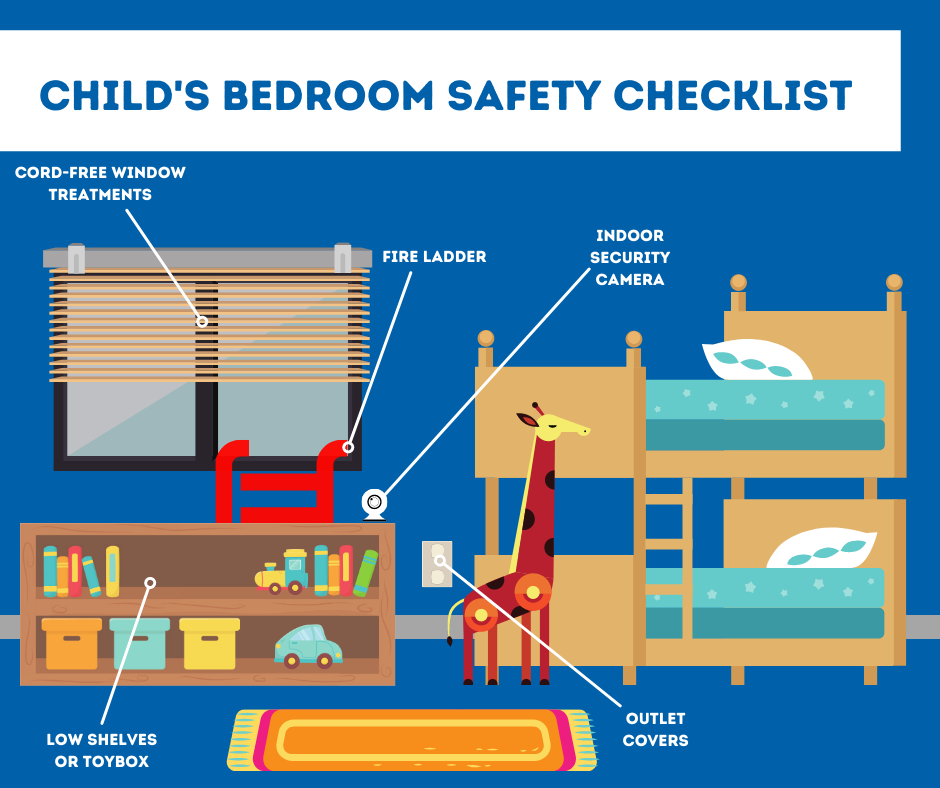
Children’s Bedroom Safety Checklist For Baltimore
A child’s bedroom should pair safety with manageability. If their window coverings or other things are safe but difficult to manage, then your kids may perform risky methods -- like scale a dresser -- to touch them. Here are 5 simple, and safe, ideas:
-
Cord-Free Window Treatments: Safety experts have long called cords from shades and blinds an unsuspecting danger for both children and pets. Put in motorized treatments that kids can easily control via remote control. Or even better, pair your motorized treatments to your ADT security system so they open without anyone’s help when the sun comes up, and go down at bedtime for added darkness.
-
Tableside Security Camera: An indoor security camera perched on your child’s desk or dresser can double as a high tech baby monitor that you can watch with your phone. And when they want you, they can hit the intercom talk feature included on the camera.
-
Outlet Plug Covers: While each outlet should have protective covers on them when you have small children, this is especially needed in a child’s bedroom. It’s the one room in your home where your child will most likely play solo without consistent adult supervision.
-
Window Escape Ladder: If you have bedrooms on the second story, then you need to put in a window fire ladder. These will let a young one leave the house even if the stairway or downstairs are blocked off with fire. Remember to go over how to unfurl the ladder a few times a year.
-
Toy Chest Or Low Shelves: It’s weird to look at a toy box as a safety item, but you’ll get it if you’ve ever walked on an action figure in your socked feet. A uncluttered floor gives your child a quick way out when there’s an emergency.
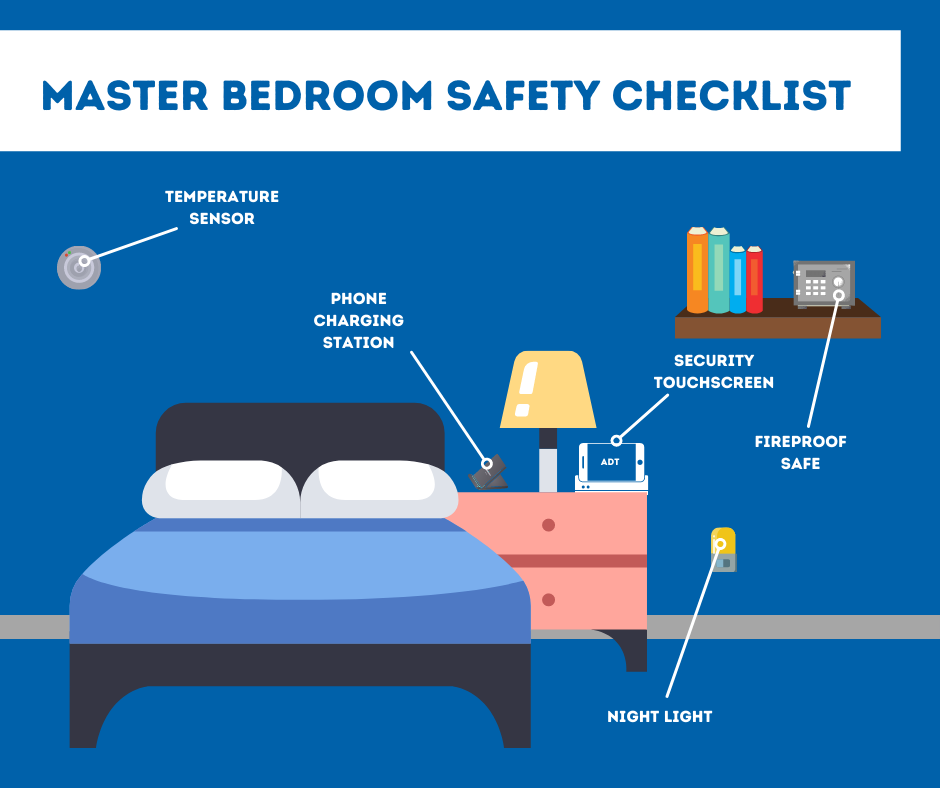
Master Bedroom Safety Checklist For Baltimore
Your main bedroom should be a refuge, so let your safety devices give you peace of mind when there's an emergency event. After all, being startled awake by a wailing alarm can be confusing.
-
Home Security Touchscreen: Having a touchscreen on your bedside table helps you know what’s going on without getting out of bed. You could always turn on your ADT smartphone app. However, the touchscreen may be easier to use to use when you’re bleary-eyed and confused.
-
Phone Charging Area: We rely on our cell phones for so many things now alarm clocks, internet searches, social media, and sometimes even phones. However, a depleted cell will cut us off from communications if something goes wrong. To keep it nice and ready, a charging cord or station becomes an important part of your nightstand.
-
Nightlights Or Voice Activated Smart Lights: A plug-in light can be a beacon when you’re startled awake from an alarm or other sounds. If you won’t drift off to sleep with a nightlight, install smart bulbs in your bedroom. Then you can get light anytime with a button push or vocal command.
-
Fireproof Safe: Stash your essential paperwork like social security cards, stock certificates, or a spare checkbook in a fireproof safe. Your lockbox can be a big one that is located out of the way or a slender portable lockbox that you can carry as you escape during a fire or other emergency.
-
Heat Sensor: The issue with a master bedroom is that they tend to be too warm or be cold since they sit across the house from the thermostat. A temperature sensor can talk to your smart thermostat so you should have a pleasant, restful sleep at just the right temperature.
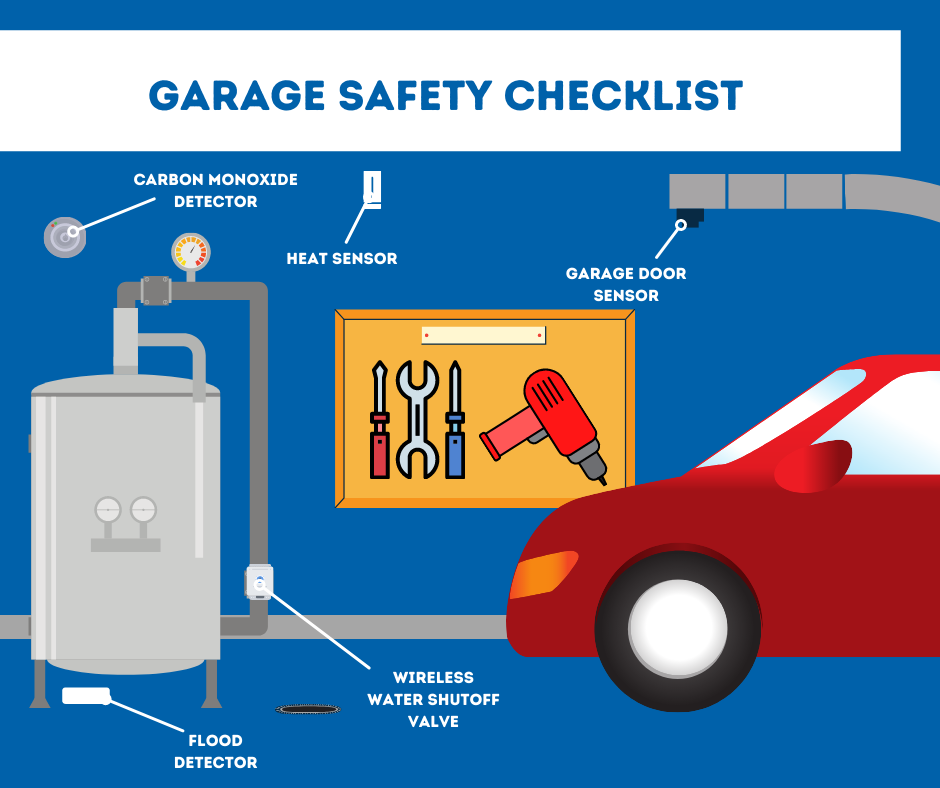
Basement/Garage Safety Checklist For Baltimore
Most safety issues in the garage or basement have to do with your pipes or heating system. Seeing hazards early can stop bigger problems in the future. So, as you walk around your garage or basement, pay attention to these safety items:
-
Flood Detector Or Sump Pump Alarm: Installing a flood sensor in back of your water heater or sump pump drain can stop you from wading into a lake when you step into your basement or garage. Do you really want to waste your weekend drying the floor?
-
CO Detector: It’s beneficial to have a CO detector in an area where a CO leak can spring up. If you employ a gas furnace, try to put an alarm in the same room as your inbound pipes.
-
Remote Water Shutoff Valve: If your flood sensor detects a hot water leak or a broken pipe, then you need to cut off the primary water pipe quickly. With a remote shutoff valve, you can turn off your water flow from any mobile device. That’s perfect when you’re on vacation and get an emergency leak alert on your smartphone.
-
Garage Door Sensor: Leaving the garage up leads to all sorts of headaches. You can lose a bunch of heat or air through that open door, and all sorts of animals or lurkers can just wander in. A remote sensor will text you about a neglected garage door and lets you lower it remotely.
-
Heat Sensor: A temperature sensor in your basement or garage is handy if you worry about freezing pipes. The temperature in these rooms can be wildly different than the rest of the home, so you will need to keep a constant look on the temperature by using the ADT mobile app.

Home Perimeter Safety Checklist for Baltimore
Your yard, driveway, and front walk are just as important to defend as the interior of your house. Use this checklist to create a safe outside:
-
Doorbell Camera: See who’s at the the front step before you open it and chat with guests. See deliveries and look at video clips if they vanish off the step.
-
Outdoor Camera: You can hang outdoor security cameras to notify you about suspicious movement in your yard. These devices are especially useful in places where you might not have a window -- like around a cellar or by the garage door.
-
Low Bushes: Tall foliage can create some serenity, but they also obscure your view of the yard. Don’t give potential burglars an area to hide. Plus, large bushes or trees too close to your house can clog gutters and invite ants and termites.
-
ADT Yard Signs: One of the most popular deterrents for home intrusion is alerting potential intruders that you own an updated ADT security system. An ADT yard sign by the main walk and a window decal will show ne'er-do-wells that they might want to shove off to an easier score.
-
Motion Activated Flood Lights: Light is the largest enemy to people who skulk in the shadows. Motion-controlled lights on your deck, patio, or garage can help scare possible intruders away. Flood lights also help you see the walk when you get home on those dark, winter nights.
Use Secure24 Alarm Systems To Help You Finish Your Home Safety Checklist for Baltimore
While Secure24 Alarm Systems can’t deliver each household item on your Baltimore home safety checklist, we can bring you a state-of-the-art home security. With easy-to-use devices and ADT monitoring, we can install the best system for your home’s needs. Simply phone (410) 934-3289 and talk to a professional or fill out the form below. Or personalize your own system with our Security System Designer.
